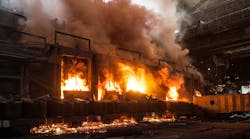Ignition sources are present in nearly any industrial or commercial facility. You can’t eliminate them, but you can keep them away from combustibles. Suppose you have a work order that calls for repairing a mounting bracket in a storage area for bales of paper. Welding is required. How can you prevent the ignition of that paper?
Possible solutions include:
- Unbolt the bracket, weld it in the shop, and return to bolt the bracket back in place. This assumes the bracket can be unbolted.
- Move the paper bales out of that area or at least move them far enough away to create a safe work area. This could require much time and effort.
- Move a few bales away, and erect a spark-proof barrier of sufficient height and width to prevent sparks from reaching the bales.
- Question the work order. Is the bracket really needed? Why is welding required? Is there another repair method (e.g., bolting or epoxies) that’s safer for this area?




